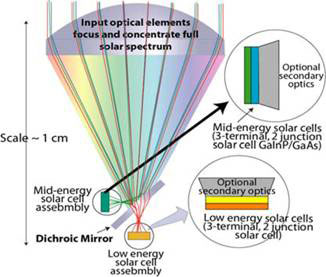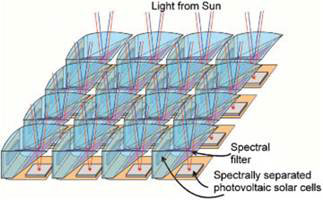The highest efficiency solar cells use innovations in optics to concentrate sunlight Brett Cherry
Much progress has been made in utilising new materials to produce low efficiency, low cost solar cells, but currently the backbone of the global solar industry is still silicon. The same semiconductor material that was used to build the physical infrastructure of the IT revolution also forms the basis of the solar energy revolution. Today, the largest demand for silicon comes from the solar industry, with Europe accounting for over 80 percent of global solar photovoltaic (PV) demand in 2008, followed by the U.S., South Korea and Japan for new solar installations [1]. Solar cells made from silicon and other PV materials have reached efficiencies over 40 percent. These high efficiencies are achieved by concentrating solar light onto solar devices with three or more solar cells. New pathways of research are also opening up to develop methods of storing solar energy through artificial photosynthesis that potentially could be used in tandem with solar technologies, such as very high efficiency solar cells (see [2] Harvesting Energy from Sunlight with Artificial Photosynthesis , SiS 43).
High efficiency solar modules appear to be primarily for industrial application so far. But the goal of many PV researchers is to make these devices cheaper for micro-generation in the commercial markets. There are a number of strategies to accomplish this. One is to develop super efficient solar PV cells in order to produce a higher power output that compensate for the material costs. Another is to make relatively low efficiency solar cells with cheaper materials as in the case of organic, dye sensitised and amorphous silicon solar cells (see [3] Which Energy? I-SIS Energy Report). Using solar concentrators or reflectors in conjunction with highly efficient silicon solar cells has been the most popular method for solar researchers.
Professor Allen Barnett and a team of solar researchers at the University of Delaware along with more than 12 other organisations in the US have developed the highest efficiency solar PV device in the world so far. They plan to develop a solar cell module of 50 percent efficiency, a project funded by the Defense Advanced Research Projects Agency (DARPA) and managed by the chemical company Dupont. Once fully developed, it could be the highest efficiency solar PV device for commercial application.
The solar PV device being developed by Barnett, the principal investigator of the project, and the Very High Efficiency Solar Cell (VHESC) team uses a lateral optical concentrator that tracks the sun to focus sunlight onto different solar cells. Each solar cell in the device consists of multiple junctions such as gallium indium phosphide and gallium arsenide (GaInP/GaAs), gallium indium arsenide phosphide and gallium indium arsenide (GaInAsP/GaInAs) [4], and silicon filtered by GaAs at 20-50 suns. In order to test how this design works, researchers concentrated sunlight using a double-convex lens then guided it to a dichroic mirror where it is split into two bands of light for absorption by the sub-module made up of “low” and “mid-energy” tandem solar cells as shown in Fig. 1. The same design would be used for a device with more solar cells.

Figure 1. The dichroic mirror diverts two bands of light to be absorbed by two different tandem solar cells of the sub-module tested [5]
Dichroic mirrors are used in LCD projectors because they divert infrared light away from the light bulb to prevent over-heating. Dichroic materials are also used in jewellery and architecture because they reflect many bright and beautiful colours. In the application for solar cells, Barnett says they have high optical efficiency and virtually no losses due to absorption, and replace the prisms that have been used previously with multi-junction solar cells.
“The mirrored approach is one of the innovations of this work,” said Barnett. Another important factor is that the solar cells do not need to be in electrical series to produce power. “We really opened the design space and having done that, there is a lot more we can do,” he said. In other multi-junction solar modules, solar cells are stacked together in order to absorb different bands of light, in this design they are parallel which also allows each solar cell to be optimised for absorbing different parts of the solar spectrum. Each solar cell in the module has separate electrical contacts, eliminating the need for electrical series connections of the solar cells and since the solar cells are arranged laterally, this also reduces the need for them to be connected in optical series (see Fig. 2).
While the sum of the efficiencies of each solar cell used in the sub-module is high, recently measured at 44.3 percent [6], individual solar cell efficiency is only part of making a solar PV device that performs well. For multi-junction solar cells using concentrators, optics is crucial as the more sunlight concentrated onto the solar cells, the greater the module’s efficiency. This is where non-imaging optics comes into the VHESC team’s design, allowing concentrators to achieve ultra high optical efficiencies.
Non-imaging optics was originally discovered by Dr. Roland Winston of University of California, Merced in the US in the 1970s, Winston has used non-imaging optical designs for solar thermal energy concentrators through the company SolarGenix Energy based in Chicago, Illinois [7]. The non-imaging optics concentrator designed by Winston is “essentially a funnel” where light enters from a large area and is reflected as it passes through a smaller area. “With non-imaging optics you don't need the image of the sun to hit your target, only the photons, so once you reduce the need for an image the opportunities for concentration increase significantly,” said Barnett. The solar device designed by the VHESC team uses a tiled non-imaging concentrating system that concentrates incoming sunlight onto the solar cells (see Figure 2). Non-imaging optical concentrators such as the one used by the VHESC team reach high optical efficiencies because the concentrator guides the photons to the receiving solar cells directly without creating an image. For example, in order to concentrate light with a magnifying glass it requires an image to transfer light from one point to another, but is limiting in terms of optical efficiency. In order for a lens to create an image, light must be reflected in a particular way, but if an image is not needed then light can be transferred directly for the purpose of concentrating light onto solar cells. The tiled design of the non-imaging concentrating system allows sunlight to be focused onto each solar cell in this way. Although a sun tracker has been used with the sub-module, the non-imaging concentrator itself is static and does not need to track the sun in order to concentrate sunlight.

Figure 2. Tiled non-imaging concentrating system that concentrates sunlight onto solar cells arranged laterally to absorb different parts of the solar spectrum [5]
According to Barnett, in order to reach their current goal of 40 percent module efficiency, some of the solar cells need to be close to 43 percent. As each solar cell does not need to be connected in series, it allows Barnett and his research team to “pick the best of the solar cells, not just the best of the ones that can be grown together.” Barnett says different combinations of materials can be used including: germanium, gallium, arsenide, indium and silicon, along with other materials to design a new high efficiency solar device with six junctions [6].
Once the VHESC team reaches 40 percent module efficiency, Barnett expects to see a commercial prototype in 2 years time. Recently, the team reached 39.5 percent sub-module efficiency at 30.48x concentration [6]. Barnett says this project has attracted the attention of individuals and companies throughout the solar industry. “Utilities are very enthusiastic about the potential, the more higher efficiencies become available the more opportunities increase,” he said. “I think the utilisation of solar power [electricity] is in its infancy.”
Article first published 22/07/09
Comments are now closed for this article
There are 6 comments on this article.
Thomas c Brosinski Comment left 10th January 2010 04:04:36
I’ve been getting quotes from companies that produce 20 – 25% efficient solar panels for a 5 Kw rooftop system I want for my Home in Tampa Fla 33617. My roof is constructed of asphalt shingles and the slope is approx 12 – 15 degrees. The roof has a south east & south west facings. I’m really interested in a system that has 40% efficient solar panels, which would make the array smaller.
I’m hoping you are now producing residential systems but understand that the technology is relatively new so I would like to test a system out for you if possible. Otherwise please point me the direction of any company that is producing residential systems.
Sincerely
Thomas C Brosinski MCP
7115 N Whittier St
Tampa, Fla 33617
(813) 899-9540
m.raja Comment left 19th January 2010 00:12:51
i know about recent solar cell and the recent materials in solar materials
Brett Comment left 6th August 2009 14:02:21
For further information, references are provided at the end of the article for ISIS members or can be downloaded.
dev Comment left 2nd August 2009 19:07:36
i want to know about the high efficiency solar cell process
Brett Comment left 21st January 2010 02:02:30
It sounds like you have a good place for a solar home, since the solar insolation in Florida is quite high. In regards to the highest efficiency solar panels on the market, I think SunPower still has the trump: http://us.sunpowercorp.com/
You will likely find a dealer/installer through their website that can quote a price for you. Efficiency is good, but it tends to not make as big of difference as what's generally thought, especially during cloudy weather. If you're keen on studying solar more, I would suggest Solar Living Institute in CA http://www.solarliving.org/ or Solar Energy International CO http://www.solarenergy.org/, there also could be similar organisation in FL.
The modules mentioned in the article are still in prototype I believe, but you can check University of Delaware's website for more info, if it's available.
VLADIMIR KARASEV Comment left 19th June 2011 20:08:06
Colleagues, good afternoon!
We offer you a new innovative product - the solar cells with an
efficiency of 35%.
We developed the technology and began to produce solar Cell 156 mm
with an efficiency of 35%( 6,5 Watt\Cell). Notify your email address we will send you
a presentation of technology, photography and performance. My e-mail:vladimirkarasev1@gmail.com